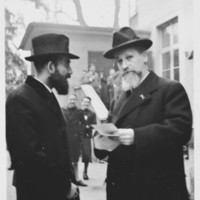Browse Exhibits (19 total)
Course Syllabus
This course examines the history of Nazi Germany and the Holocaust against the backdrop of global trajectories of antisemitism, colonialism, racial science, and economic crisis. Major themes include the rise of the Nazi Party in Germany; the sources of Nazi antisemitism; the role of race, gender, and disability in the Nazi state; the origins of World War II; the decision to annihilate European Jewry; collaboration and resistance during the Holocaust; the relationship between statelessness and genocide; and postwar legacies. Special attention will be paid to primary sources and methods of analyzing testimonies by Holocaust perpetrators and victims.
Research Projects
Exhibits from HIST 1049: Biographies of Sites of Nazi Persecution, Confinement, and Genocide
Heinz Bohm's Experience in 1930's Duisburg, Germany
As a young Jewish boy, Heinz Bohm witnessed the rise of the Nazi Party in his home town of Duisburg, Germany. Born in 1922, he lived through the transition from the democratic Weimar Republic into the authoritarian Nazi Regime. This analysis pays special attention to Heinz's relationship with his non-Jewish counterparts, and how those relationships changed over the course of the 1930s.

Esther Clifford
Esther Clifford (nee Ebe) was born on December 5th, 1920 in Munich, and grew up in Frankfurt. Her parents had immigrated to Germany from Poland shortly before she was born, and this analysis focuses on the influence her Polish heritage had on her experiences during the period from 1933 to 1938.
Julia Bäcker Lentini
Julia Bäcker Lentini was born in a hospital in Eisern, Germany on April 15, 1926, but called Biedenkopf, Germany home. She is Roma and Sinti, but her family was only nomadic during the summertime. The rest of the year she, her 14 siblings, and parents lived in their family home. Compared to other Roma and Sinti in war torn Germany, the Bäcker family was taken into Nazi imprisonment relatively late. This exhibit explores Lentini’s childhood and life while also considering why her family was spared persecution for as long as they did.
Testimony Analysis of Ruth Winterfield by Sean Roades
In this exhibit, I connect the account of Ruth Winterfield, a Holocaust survivor, with the ideas of Christopher Browning and Marion Kaplan as it relates to the rise of antisemitism in pre-World War II Nazi Germany.

Krakow-Plaszow Concentration Camp
This exhibit will analyze the Krakow (Krakau)-Plaszow concentration camp that existed in Poland from October 1942 to January 20, 1945. The Krakow-Plaszow main camp was built in the Plaszow suburb of Krakow, Poland by the Nazi regime after the Polish invasion, by the order of the SS staff and Police Leader Oberfuhrer Julian Scherner (Jarkowska-Natkaniec 154; Megargee 862). Plaszow largely served as a labor camp used to mediate transportations of Polish Jews and non-Jews from nearby concentration camps and the Krakow ghetto to Auschwitz, but officially became a concentration camp in early 1944 and lasted for 12 months until the fear of oncoming Allies motivated Nazi leadership to ‘liquidate’ the camp and transport any remaining prisoners to Auschwitz or other nearby killing centers. The Krakow-Plaszow camp had 3 subcamps: Zablocie, Wieliczka, and Mielec. Zablocie was famously depicted in Steven Spielberg’s Schindler’s List, which this exhibit will analyze for validity and impact. This exhibit will also examine the living conditions of the Krakow-Plaszow camp, survivor testimonies of the Zablocie camp and Plazow main camp, and how the camp and its leading officers were dealt with after the war. Around 30,000 - 50,000 prisoners went through the Plaszow main camp, and at least 5,000 - 8,000 prisoners died under the camp’s strenuous and terrifying living conditions and harsh camp commandant Amon (Goeth) Goth (Megargee, 2009). This exhibit cannot capture each of the prisoners’ unique experiences, but it will attempt to serve as a reflection of what generally happened at the Plaszow camp, and its consequences.
